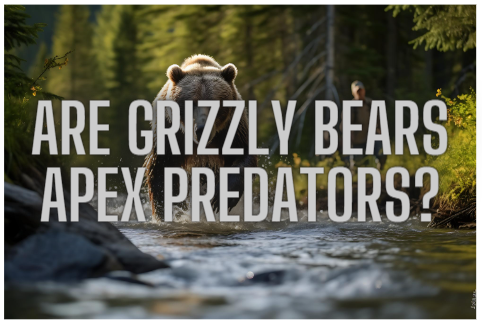Grizzly bears (Ursus arctos horribilis) are majestic creatures that have long captivated our imagination with their sheer size, power, and presence. These magnificent animals, found in North America’s wilderness, hold a prominent place in the ecosystem as apex predators. In this article, we will explore the characteristics and behaviors that make grizzly bears formidable apex predators, highlighting their role in maintaining ecological balance and the challenges they face in an evolving environment.
Physical Attributes and Adaptations
Grizzly bears are among the largest land-dwelling carnivores, with adult males weighing up to 600 kilograms (1,300 pounds) and standing up to 2.5 meters (8 feet) tall on their hind legs. Their muscular bodies, humped shoulders, and long claws are well-suited for various aspects of their predatory lifestyle. These powerful creatures possess an excellent sense of smell, allowing them to detect prey and carrion from miles away. Additionally, their sharp, non-retractable claws enable them to dig dens, forage for food, and defend themselves against potential threats.
Diet and Hunting Strategies
Grizzly bears are omnivorous, meaning they consume both plant and animal matter. Their diet primarily consists of grasses, berries, nuts, roots, insects, fish, and small mammals. During the salmon spawning season, grizzlies gather at rivers and streams, utilizing their fishing prowess to catch the nutrient-rich fish. Their hunting strategies may vary depending on the availability of food sources. While grizzlies are often opportunistic feeders, they also possess remarkable hunting skills. They are capable of ambushing prey, chasing down fast-moving animals like deer or elk, and even scavenging carcasses left behind by other predators.
Ecological Role
As apex predators, grizzly bears play a crucial role in maintaining the ecological balance of their habitats. By controlling prey populations, they help regulate the distribution of herbivores, preventing overgrazing and promoting healthy vegetation. Grizzlies help disperse seeds through their scat, aiding in forest regeneration. Moreover, their feeding habits contribute to nutrient cycling by redistributing organic matter across landscapes.
Interaction with Other Species
Grizzly bears interact with various species, both as predators and competitors. They often compete with other large carnivores, such as wolves and cougars, for resources and territory. While confrontations between these predators occasionally occur, they also have been observed coexisting in the same areas, each occupying different niches. The scavenging habits of grizzlies also benefit smaller scavengers, like ravens and bald eagles, as they feed on leftover carcasses left by the bears.
Conservation Challenges
Grizzly bears face numerous conservation challenges due to habitat loss, human encroachment, and climate change. The fragmentation of their habitats restricts their movement and gene flow, leading to reduced genetic diversity within populations. Additionally, conflicts arise when grizzlies come into contact with humans, leading to concerns for public safety. Conservation efforts have focused on creating protected areas, implementing wildlife corridors, and promoting coexistence strategies to mitigate human-bear conflicts.
Final Thoughts
Grizzly bears are undeniably apex predators, occupying a significant ecological niche in the wild. Their physical attributes, hunting prowess, and ecological role make them vital to the functioning of ecosystems they inhabit. However, the conservation of grizzly bears remains an ongoing challenge, requiring concerted efforts to protect their habitats and ensure their long-term survival. As we strive to preserve the natural world, it is essential to recognize and appreciate the crucial role played by these magnificent creatures in maintaining the delicate balance of nature.

